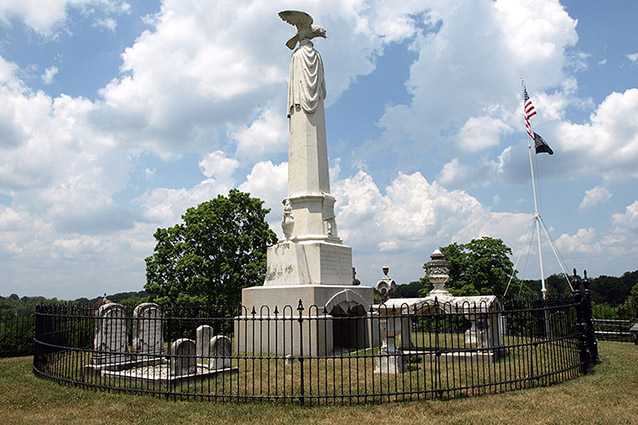Andrew Johnson National Cemetery was established in 1906 on a hilly tract of land outside Greeneville, TN. It included the gravesite of Andrew Johnson, 17th President of the United States, and a small burial ground for his immediate family. In 1901, Johnson’s daughter, Margaret Johnson Patterson willed the burial ground to the federal government for use as a public park in commemoration of the former president.
The rural cemetery represented a departure from the grim, axial graveyards of colonial America for a more hopeful and inviting landscape.

NPS
The National Cemetery was administered by the War Department until 1942, when it was designated a National Monument and transferred to the NPS. The cultural landscape includes historic features from two periods of significance, the first associated with the use of the land by the Johnson family as a burial ground, and later the establishment and development of the National Cemetery by the War Department. During the first period of significance (Johnson Family Burial Ground, 1875-1906), monuments were erected within and around an elaborate cast iron fence. Contributing features from this time period, including the Andrew Johnson Monument (1878), are present today.
Most of the remaining historic features date to the second period of significance (War Department era, 1906 1942), which encompasses the development of the National Cemetery landscape under the War Department. This period is reflected by features associated with the original War Department design, including buildings and structures (cemetery wall and gate, lodge, stable, rostrum), roads (Monument Drive, Service Road), the original nine grave sections, walkways, flagstaff, and drainage features. The World War I Machine Gun Monument (1931) also dates to this era.

NPS
Individual features and their arrangement across the landscape convey a clear connection with the two periods of significance. The purpose of this cemetery as it was designated in 1906 – to honor the veterans of the armed forces and commemorate the 17th U.S. President – has not been altered. When NPS policy put an end to burials in the National Cemetery in 1942, public outcry was so persistent that officials overturned the policy. The original site mission to preserve the cemetery as it was at the end of the War Department era in 1942 was compromised by the plan to maximize burial space within the cemetery.
After the burial of Johnson in 1875, the gravesite expanded into a small family plot with the Johnson Monument as its nexus. Through its architecture and arrangement, the Johnson family plot conveys characteristics of the rural cemetery movement and the romantic ideals that characterized American funerary architecture in the late Victorian era.
The rural cemetery movement began in 1831 and went on to forge a new class of cemetery. Skilled architects were employed to create designs that were characterized by their location on the outskirts of cities and by the presence of winding pathways, vistas, and architecture that fostered a contemplative atmosphere. The Johnson family burial ground conveys the defining characteristics of the movement. The family plot was established at an elevated site on the outskirts of town with expansive views. A winding road provided the ascent to the gravesite typical in rural cemetery designs, intended to foster an appreciation of the setting. The War Department began their transformation of the landscape in 1906 and retained these features.

NPS
After the transfer of the family plot from Johnson’s heir to the federal government, the War Department took steps to begin the transformation of the landscape into a traditional national cemetery in 1908. Andrew Johnson National Cemetery was developed following design standards established under General Montgomery C. Meigs in the 1870s. The General Development Plan of 1908 included the layout of the cemetery lodge, cemetery roads, memorial approach and walkways, flagstaff, stable, nine grave sections, cemetery wall and gate, drainage features, and the cemetery rostrum.
Quick Facts
- Cultural Landscape Type: Designed
- National Register Significance Level: National
- National Register Significance Criteria: B,C
- Period of Significance: 1875-1906, 1906-1942
Landscape Links
Last updated: December 31, 2020
